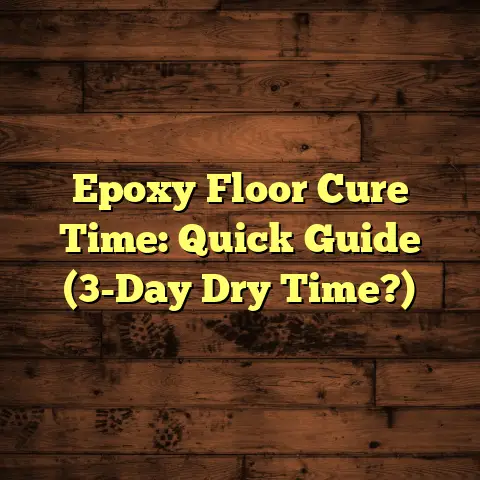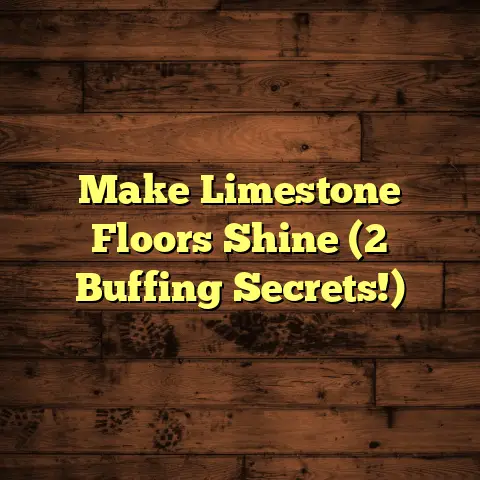Wash Laminate Floors Too Often? (8 Mistakes)
Introduction: Regional Focus on Laminate Flooring Use in the Midwest
I’m a flooring contractor here in the heartland, and let me tell you, I’ve seen it all when it comes to laminate flooring.
From cozy cabins up north to bustling city apartments, laminate is a super popular choice for its durability, affordability, and how darn good it looks.
But here’s the thing: a lot of folks are washing their laminate floors too often, and that can actually cause more harm than good.
Think of it like over-watering your plants – you’re trying to help, but you’re actually drowning them!
In this article, I’m going to share eight common mistakes I see people make when washing laminate floors.
I’ll give you the lowdown on how to properly care for your floors so they stay looking fantastic for years to come, even with our crazy Midwest weather. Ready? Let’s dive in!
1. Over-wetting the Floors
Okay, this is the biggest mistake I see, hands down.
Laminate is water-resistant, not waterproof. Think of it like a good raincoat – it can handle some drizzle, but it’s not meant for a full-on downpour.
When you soak your laminate floors with too much water, that water can seep into the seams between the planks.
What happens then?
Warping, swelling, and even delamination (that’s when the layers of the laminate start to separate). Not good!
I’ve seen floors that look like rolling hills because of this.
How do you avoid this?
- Use a barely-damp mop: Wring it out until it feels almost dry to the touch.
- Spray sparingly: If you’re using a spray mop, use a fine mist and don’t overdo it.
- Clean up spills immediately: Don’t let liquids sit on the floor.
2. Using Harsh Chemicals
I get it. You want a deep clean, especially after the kids track in mud from the backyard.
But those harsh chemicals you might be tempted to use? They’re like kryptonite for your laminate.
Many of these cleaners can strip the protective layer on the floor, making it dull and prone to scratches.
I’ve seen folks use bleach, ammonia, and even vinegar (yes, even vinegar can be too acidic).
What should you use instead?
- Laminate-specific cleaners: These are formulated to be gentle yet effective. Look for pH-neutral options.
- Mild dish soap: A tiny bit of dish soap in warm water can work wonders.
- DIY solution: Mix a cup of white vinegar with a gallon of water for a gentle cleaner. But test it in an inconspicuous area first!
3. Ignoring Manufacturer’s Guidelines
This is a biggie! Every laminate flooring product is different, and the manufacturer knows best how to care for it.
I can’t tell you how many times I’ve heard, “Oh, I didn’t even look at the instructions.”
Big mistake!
Those guidelines aren’t just suggestions; they’re there to help you protect your investment.
What to do:
- Find the manual: Dig out the installation manual or look it up online.
- Read the fine print: Pay attention to recommended cleaners, cleaning methods, and warranty information.
- Follow the instructions: Stick to the manufacturer’s recommendations to avoid voiding your warranty.
4. Using the Wrong Cleaning Tools
Think of your laminate floor as a delicate surface.
Would you scrub your car with a steel wool pad? Of course not!
So why would you use abrasive cleaning tools on your floor?
I’ve seen people use scrubbing pads, stiff-bristle brooms, and even steel wool (yikes!).
These can scratch the surface and dull the finish.
What are the right tools for the job?
- Microfiber mop: These are super absorbent and gentle on the floor.
- Soft-bristle broom: For sweeping up loose dirt and debris.
- Vacuum with a soft brush attachment: Avoid using a beater bar, as it can scratch the floor.
5. Cleaning Too Frequently
I know, I know, you want your house to be spotless.
But washing your laminate floors every single day is overkill.
Over-cleaning can strip the protective layer and lead to unnecessary wear and tear.
Think about it: every time you wet the floor, you’re introducing the risk of water damage.
How often should you clean?
- High-traffic areas: Kitchens, entryways, and hallways might need cleaning once a week.
- Low-traffic areas: Bedrooms and living rooms can often go two weeks or more between cleanings.
- Spot clean as needed: Clean up spills and messes as they happen.
According to the National Wood Flooring Association (NWFA), you should dust mop or vacuum wood/laminate floors frequently – even daily if necessary. NWFA Cleaning Tips
6. Neglecting Drying Time
You’ve washed the floor, and now you’re in a hurry to get on with your day.
But walking on a wet laminate floor is a recipe for disaster.
Not only can you slip and fall, but you can also trap moisture beneath the surface.
This can lead to mold growth, discoloration, and even more serious floor damage.
What’s the solution?
- Allow sufficient drying time: Let the floor air dry completely before walking on it.
- Use a fan: A fan can help speed up the drying process.
- Open windows: Ventilation is key to preventing moisture buildup.
7. Overlooking Protective Measures
An ounce of prevention is worth a pound of cure, right?
That’s especially true when it comes to laminate flooring.
I see so many people neglecting to use protective measures like area rugs and mats, especially in high-traffic areas.
These can help reduce the amount of dirt and grime that reaches the laminate surface, minimizing the need for frequent cleaning.
What protective measures should you take?
- Area rugs: Place rugs in entryways, hallways, and under furniture.
- Mats: Use mats at doorways to trap dirt and moisture.
- Furniture pads: Protect your floors from scratches by placing pads under furniture legs.
8. Disregarding Environmental Factors
Here in the Midwest, we experience some pretty extreme weather conditions.
From sweltering summers to freezing winters, our homes are constantly exposed to changes in humidity and temperature.
These fluctuations can affect your laminate flooring.
For example, high humidity can cause the floor to expand, while low humidity can cause it to contract.
How can you protect your floors from the elements?
- Use a humidifier or dehumidifier: Maintain a consistent humidity level in your home.
- Adjust your cleaning routine: Clean more frequently during the winter months when salt and snow can be tracked indoors.
- Consider seasonal maintenance: Apply a laminate floor protector in the fall to help seal the surface and prevent damage from winter weather.
Conclusion
So, there you have it – eight common mistakes to avoid when washing your laminate floors.
By following these tips, you can keep your floors looking beautiful for years to come, all while navigating the unique challenges presented by our Midwest climate.
Remember, a little bit of knowledge and care can go a long way in protecting your investment.
Now go forth and conquer those floors! And if you ever need help, you know where to find me.





